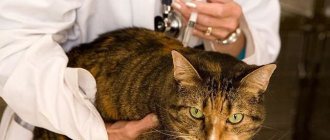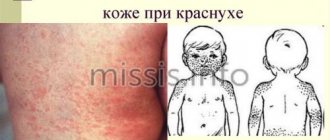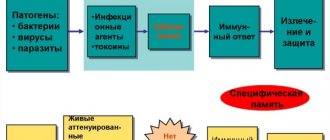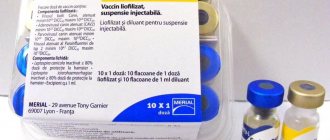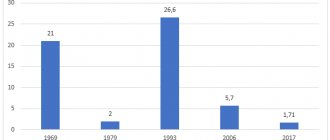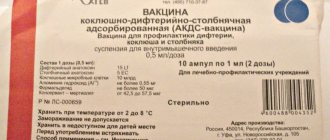Rabies vaccine culture concentrated purified inactivated
Dosage regimen and method of administration
The contents of the vaccine ampoule must be dissolved in 1.0 ml of water for injection.
Dissolution time should not exceed 5 minutes. The dissolved vaccine is a clear or slightly opalescent liquid from colorless to light yellow. The dissolved vaccine is injected slowly intramuscularly into the deltoid muscle of the shoulder, for children under 5 years old - into the upper part of the anterolateral surface of the thigh. Injection of the vaccine into the gluteal region is not allowed.
Providing anti-rabies assistance
Anti-rabies care consists of local treatment of wounds, scratches, abrasions, salivation sites and subsequent administration of the COCAV rabies vaccine or, if indicated, the combined administration of rabies immunoglobulin (RAI) and COCAV rabies vaccine.
The interval between the administration of AIH and COCAV is no more than 30 minutes.
Local wound treatment
Local treatment of wounds (bites, scratches, abrasions) and drooling areas should begin immediately or as soon as possible after a bite or injury. It consists of abundantly washing the wound surface for several minutes (up to 15 minutes) with water and soap or another detergent (detergent), or, in the absence of soap or detergent, the injury site is washed with a stream of water.
After this, the edges of the wound should be treated with 70% ethyl alcohol or a 5% alcohol solution of iodine. Sutures should be avoided whenever possible.
Suturing is indicated only in the following cases:
- for extensive wounds - several guiding skin sutures after pre-treatment of the wound;
- for cosmetic reasons (skin sutures on facial wounds);
- suturing of bleeding vessels in order to stop external bleeding.
If there are indications for the use of rabies immunoglobulin, it is used immediately before suturing (see section Dosage of rabies immunoglobulin (RAI)).
After local treatment of wounds (damages), therapeutic and prophylactic immunization is immediately started.
Therapeutic and preventive immunization
Indications. Contact and bites of people by animals with rabies, animals suspected of having rabies, wild or unknown animals.
Contraindications. None.
Pregnancy is not a contraindication.
All persons at risk of contracting rabies are subject to therapeutic and prophylactic immunization. If there are indications for combination treatment, then AIH is first administered and, no more than 30 minutes later, COKAV is administered after it.
Rabies immunoglobulin (RAI)
prescribed as soon as possible after contact with a rabid animal or an animal suspected of having rabies, wild or unknown animals.
Before administering heterologous (equine) rabies immunoglobulin, it is necessary to check the patient’s individual sensitivity to horse protein (see “Instructions for the use of rabies immunoglobulin from horse blood serum, liquid”).
Individual sensitivity is not tested before administration of homologous (human) rabies immunoglobulin. Heterologous anti-rabies immunoglobulin is administered no later than 3 days after the bite, homologous anti-rabies immunoglobulin is administered no later than 7 days after the bite.
Dose of rabies immunoglobulin (RAI). Heterologous (equine) rabies immunoglobulin is prescribed at a dose of 40 IU per 1 kg of body weight.
The volume of administered heterologous rabies immunoglobulin should not exceed 20 ml. Homologous (human) rabies immunoglobulin is prescribed at a dose of 20 IU per 1 kg of body weight.
Administration of rabies immunoglobulin (RAI). As much of the recommended dose of AIH as possible should be infiltrated into the tissue around the wound and deep into the wound.
The unused portion of the drug dose is injected deep intramuscularly into a site other than the rabies vaccine.
Preventive immunization
Indications. For preventive purposes, people who have a high risk of contracting rabies are immunized (laboratory employees working with the street rabies virus; veterinarians; rangers, hunters, foresters; persons performing work on catching and keeping animals and other professional groups).
The vaccine is administered intramuscularly into the deltoid muscle of the shoulder, 1.0 ml on days 0, 7 and 30. Revaccination is carried out once, in a dose of 1.0 ml every year and then every three years.
Instructions for the use of rabies vaccine
Instructions for use of the Rabikan anti-rabies inactivated dry culture vaccine from the Shchelkovo-51 strain for dogs and cats (Developer organization: FKP "Shchelkovo Biocombine", Moscow region)
I. General information International nonproprietary name - inactivated dry culture rabies vaccine from the Shchelkovo-51 strain for dogs and cats (Rabican). Dosage form - lyophilized mass.
The vaccine is made from β-propiolactone-inactivated rabies virus strain “Shchelkovo-51” with the addition of 33.3% sucrose-peptone-gelatin stabilizer. In appearance, the vaccine is a dry, porous mass of yellowish-brown color, which, when sterile distilled water is added in a volume equal to the volume of the vaccine in the vial before drying, dissolves within 1-2 minutes to form a transparent yellowish-brown liquid.
The vaccine is packaged in 2 packs; 4 or 10 cm3 (1; 2; 5 doses for large breed dogs or 2; 4; 10 doses for cats, puppies and adult dogs of small decorative breeds) in bottles of appropriate capacity, hermetically sealed with rubber stoppers reinforced with aluminum caps. The vaccine vials are packaged in boxes with dividing partitions to ensure their integrity. Each box of vaccine contains instructions for its use. Boxes with the vaccine are packed in boxes or corrugated containers.
The shelf life of the vaccine is 24 months from the date of release, subject to storage and transportation conditions. After the expiration date, the vaccine is not suitable for use.
The vaccine is stored and transported in a dry, dark place at a temperature of 2°C to 8°C or at any sub-zero temperature. It is allowed to transport the vaccine in the packaging of the manufacturer at a temperature not exceeding 25°C for no more than 10 days. The Rabican vaccine should be stored out of the reach of children.
Vaccine in vials without markings, with a violation of the integrity and/or tightness of the closure, with a changed color and/or consistency, with the presence of foreign impurities, with an expired expiration date, as well as vaccine residues not used within 4 hours after opening the vials are subject to discarding and disinfection by boiling for 30 minutes or treating with a 2% alkali solution or a 5% chloramine solution (1:1) for 30 minutes. Vaccine vials, syringes and needles are treated in the same way. Disposal of decontaminated vaccine does not require special precautions.
II. Biological properties The vaccine causes the formation of an immune response to the rabies pathogen in primary vaccinated animals from 5-7 days after a single injection of the vaccine; immunity reaches its maximum by 30-40 days and persists for 1 year. In the case of a two-time vaccine administration, with revaccination after 30-50 days, immunity lasts for 2 years. The immunogenic activity (immunogenicity index) of the vaccine is at least 1 IU/cm3. The vaccine is harmless and has no medicinal properties.
III. Directions for use The vaccine is intended for preventive and emergency vaccination of dogs and cats against rabies.
It is prohibited to vaccinate animals suspected of having rabies.
Dogs and cats are subject to vaccination starting from 2 months of age. Vaccination is carried out in compliance with the rules of asepsis and antiseptics. Before use, the dry vaccine is reconstituted to the original volume indicated on the label with sterile distilled water. The drug is administered subcutaneously. The injection site is wiped with a 70% solution of ethyl alcohol or another disinfectant solution. A separate needle is used for each animal.
The vaccine is administered in doses (per injection):
- dogs of large breeds (shepherds, St. Bernards, etc.) - 2 cm3;
- puppies (up to 1 year) and adult dogs of small decorative breeds (lapdogs, dachshunds, Spitz, terriers, etc.) - 1 cm3;
- cats - 1 cm3.
In rabies-free areas, preventive immunization of dogs and cats is carried out once, followed by revaccination after one year and then once every two years. Note. When the infection is introduced into these areas, animals are vaccinated without waiting for the end of the specified one-year interval between the first and second vaccinations. In the territory of stationary problems with rabies, animals are vaccinated for preventive purposes twice with an interval of 30-50 days, followed by a single revaccination once every two years. Animals previously vaccinated against rabies are given the vaccine once every two years. Forced vaccination is carried out no later than 48 hours after possible infection of animals. The vaccine is administered twice, with an interval of 14 days, in doses recommended for preventive vaccination.
There are no symptoms of rabies or other pathological signs associated with an overdose of the vaccine. The peculiarities of the post-vaccination reaction during the initial and subsequent administrations of the vaccine have not been established. Violation of the vaccination schedule should be avoided, as this may lead to a decrease in the effectiveness of rabies immunoprophylaxis. If the next dose of vaccine is missed, immunization should be carried out as soon as possible. When using the vaccine in accordance with these instructions, side effects and complications, as a rule, are not observed.
It is prohibited to use other vaccines together with the rabies vaccine, as well as to prescribe immunobiological and pharmaceutical antiviral drugs (immune serums, gamma globulin, interferon, etc.) 10 days before vaccination and within 10 days after the administration of the vaccine.
The timing of possible use of animal products after the introduction of the Rabican vaccine has not been established.
IV. Personal preventive measures When working with the vaccine, you should follow the rules of personal hygiene and safety precautions provided for when working with veterinary medicinal products. All persons participating in vaccination must wear special clothing (rubber boots, a robe, trousers, a hat, rubber gloves) and be provided with closed-type goggles. Places of work must have a first aid kit. Persons with signs of respiratory, gastrointestinal and allergic diseases are not allowed to participate in vaccination. If the vaccine gets on the skin and/or mucous membranes, it is recommended to rinse them with plenty of tap water. In the event of a vaccine spill, the contaminated area of the floor or soil is filled with a 5% chloramine solution or a 2% sodium hydroxide solution. If the vaccine is accidentally administered to a person, the injection site must be treated with a 70% solution of ethyl alcohol, contact a medical facility and inform the doctor about this.
Organization-, 141142, Moscow region, Shchelkovsky district, Biokombinata settlement.
Instructions for the use of the anti-rabies inactivated dry culture vaccine from the Shchelkovo-51 strain for dogs and cats (Rabican) were developed by the FKP Shchelkovo Biokombinat, 141142, Moscow region, Shchelkovo district, Biokombinat settlement.
With the approval of this Instruction, the “Instructions for the use of rabies inactivated dry culture vaccine from the Shchelkovo-51 strain for dogs and cats (Rabican)”, approved on March 28, 2012, becomes invalid.
